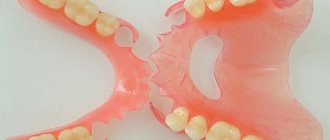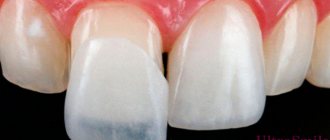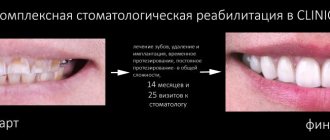Most people, one way or another, are faced with the need to visit a dentist for dental treatment or prosthetics. If the root is preserved, but the tooth itself cannot be restored with a filling, a crown prosthesis is placed. A crown is a special prosthesis that helps a tooth restore lost functions, prevent its complete destruction and restore its aesthetic appearance.
Dental crowns in our clinic
Specialists from the Beryozka clinic will help you place strong dental crowns based on an individual impression. Our doctors work according to the most modern treatment protocols, which ensures maximum similarity of the artificial crown with the real one. High-tech materials ensure long-lasting wear even with intensive use of the crown.
Making a crown based on an individual impression ensures the most comfortable use. And budget prices allow you to restore the beauty and functionality of the jaws to a person with any income.
Free consultation!
You can get acquainted with the specialists of the Beryozka clinic and decide on the need to install a crown at a free consultation. Our doctors are confident that the patient, once in their hands, will definitely return for treatment. This is facilitated by the beautiful and comfortable environment in the offices, friendly and polite staff, as well as the high professionalism of the dentists.
What is a dental crown
The visible part of a natural tooth is the crown. It is most often destroyed due to caries, trauma or the process of demineralization. It can be restored with an artificial prosthesis - a dental crown. It can be temporary - for the period of treatment, or permanent - for every day. In some cases, crowns are used to correct the shape of implants when they are damaged.
Who does prosthetics and dental implants?
If you are interested in which doctor places dental crowns, then know that this is done by an orthopedist - a doctor of narrow specialization who can combine his function with another dental specialty. Often, a prosthetist combines practice with surgical activities, since the installation of many prostheses requires surgical intervention.
The services of an orthopedic surgeon are in demand to implant an artificial root into the bone, install an abutment and fix a crown on it. Implantation is a serious intervention that requires a comprehensive diagnosis of the mouth. Based on the results, the specialist develops a prosthetic plan and makes impressions for the crown.
Contraindications
Like any medical procedure, the installation of crowns has contraindications. Cases in which the procedure is not performed:
- advanced periodontitis;
- bruxism - teeth grinding;
- fragile enamel;
- teeth are small and poorly positioned;
- pathological bite, when the incisors overlap one another.
Sometimes the age of the patient may be a contraindication to installing a crown made of a certain material. Then he is offered another way to restore the integrity of the dentition.
What is the name of the doctor who makes prostheses, and who can install them?
An orthopedic dentist performs dental prosthetics, including installing crowns. However, other specialists also work with the patient before installing the prosthesis.
- The dentist-therapist carries out treatment of the tooth, mucous membranes and gums, sanitation of the oral cavity, removal of stones and plaque.
- A dental surgeon removes a root that cannot be treated. At this stage, the surgeon implants an implant into the patient’s jaw on which the prosthesis will be installed.
- Then the dental technician gets involved in the work . Based on a cast of the patient’s jaw and other information, a prosthesis is made in a dental laboratory, which is then installed by an orthopedic dentist.
An orthopedic dentist often works in conjunction with an orthodontist to correct dentition.
What are they: materials
Crowns are made from different materials: some are more durable, others are only suitable as a temporary measure. Their cost, complexity of manufacturing and installation also depend on this.
Metal ceramics
The product has a metal frame and is covered with ceramics on top.
| Pros: | Minuses: |
| High strength. | Contraindicated for people under 18 years of age. |
| Aesthetics. | Not suitable for gum recession. |
Metal-ceramic crowns are suitable for installation only in adult patients.
Metal composite
The crown frame is made of an alloy of chromium and cobalt. From above it is covered with a photopolymer composite: while it is soft, it is given a shape, after which it is fixed with UV rays.
| Pros: | Minuses: |
| High strength. | Coloring from products with pigment. |
| Thin and invisible edges. |
People with metal-composite crowns need to follow a diet to prevent artificial teeth from changing color. It is not recommended to consume drinks with dyes and foods with a high pigment content.
Golden
The oldest material for making crowns is gold.
| Pros: | Minuses: |
| Hypoallergenic. | Lack of aesthetics. |
| They do not damage neighboring healthy teeth. | Rapid abrasion due to the softness of the metal. |
It is best to install gold crowns on the back teeth, where they will be almost invisible.
Zirconium dioxide
Modern material for crowns is zirconium dioxide. It is durable, aesthetic, does not cause allergies and lasts a long time. But it has a fairly high cost, so it’s not suitable for everyone’s budget.
Metal-free
Modern synthetic materials can completely replace metal in the composition of the crown. They are no less durable, and look as close as possible to natural teeth.
Ceramic
The best way to choose the color of a crown is when it is made of ceramic. They do not look artificial, as they are quite transparent.
They are great for replacing incisors. But for chewing teeth, ceramic crowns are too fragile and cannot withstand such a load.
Porcelain
Porcelain crowns are not so popular, but are gradually becoming more and more in demand. They are easily and firmly fixed, which reduces the risk of loosening. Porcelain products last a long time, do not deteriorate due to temperature changes and are not stained by food. In this case, the crown can be made in an anatomical shape, repeating the relief of the tooth as accurately as possible, which ensures comfortable wearing. They look very aesthetically pleasing and are also hypoallergenic.
One of the disadvantages is their loose fit to the tooth, which can cause cervical caries. Crowns are quite fragile and can destroy adjacent healthy teeth. The product is not suitable for patients with thin enamel. In addition, the cost of such crowns is quite high, which is not affordable for everyone.
Combined
By combining several materials, it is possible to create crowns that combine their best properties. The product is suitable for use on front and back teeth: they look aesthetically pleasing and can withstand chewing loads. But such crowns are short-lived because they quickly wear out and sometimes become deformed. But their installation does not cause a blow to the budget.
Plastic
Plastic crowns are used as a temporary measure. They are manufactured on site and installed on the same day in place of the extracted or treated tooth. The cost of such crowns is low. But it is impossible to use them as permanent ones, since they cannot withstand prolonged chewing load.
Types of crowns
The number of missing teeth, the presence of dentures and other individual characteristics of the patient determine what type of crown is suitable for him. It is impossible to determine this in absentia, since it requires an examination by a specialist.
Bridges
Suitable for people who have lost more than one tooth. The prosthesis is made for all missing units, and its parts are connected by a metal bridge. To secure the crowns, you need healthy chewing teeth. Only complex prosthetics are performed in this way.
Implant supported crowns
If the patient has implants, the crown can be secured to them. This will prevent the destruction of healthy teeth, which can occur due to excess stress. But the method is only suitable for those who already have implants installed.
Crown for one tooth
If one tooth is destroyed, a crown can be installed only on it. This usually happens after deep caries or injuries. Before installing a crown, the condition of the periodontium, jaw and gum tissue is assessed. Sometimes additional operations are performed to build up the bone plate.
Fixation with a pin
The rarest method of prosthetics is installing a crown on a pin. It is quite traumatic and carries a risk of complications, so it is almost never used. If other methods of prosthetics are not available to the patient, the crown is installed on a pin, but this is done in several stages under the supervision of specialists at each of them.
What does orthopedics do?
According to the definition, orthopedic dentistry deals with the identification and treatment of violations of the integrity and functions of the dental system. This is possible through the installation of removable or fixed prostheses and corrective devices. At the dawn of orthopedic dentistry, this range of services meant only prosthetics. Today, this includes the prevention of the development of jaw deformities.
Types of dental prosthetics include:
- Implant prosthetics is a universal method that is used for complete or partial tooth loss. With the help of a prosthesis, chewing function is restored. Such designs do not imply restrictions in operation.
- Inlays are special fillings that are made in advance in the laboratory. Installed using a fixing compound. Durable, do not shrink.
- Veneers are ceramic shells that are placed on the front side of teeth. Serve to eliminate external defects (irregular shape, chips, pathological abrasion of enamel). Made individually, they improve the appearance of your smile.
- Crowns are special attachments, or “caps,” that are used when a tooth is completely or partially deformed (when installing a filling is not advisable). They are made of metal-ceramics, composite materials, plastic, and metal.
- Bridges - used to replace a lost tooth or group of teeth.
They are installed using a support (at least two), which are whole healthy teeth. They are made from the same materials as crowns.
- Removable dentures - these include clasp and plate dentures. Used in cases of severe damage to the dentition.
Methods for making a crown
Orthodontic products can be manufactured using several methods. Each of them has its own advantages and disadvantages.
Cast products
Strong and durable crowns are made using casting. For this, a single piece of metal is used. The method is not suitable for all materials.
Stamped
More affordable, but less durable prostheses are made by stamping:
- a mold is placed into the dental anvil;
- using rubber rings a stamp is obtained;
- the crown is made using special hammers that differ in shape and size;
- The product is given its final shape using small tongs.
Such crowns last less than cast ones, but are much cheaper to produce.
Digital protocol - for maximum accuracy
A digital impression, a 3D image of the jaw, and a computer model of the future smile are digitally transferred to the laboratory. Manufacturing accuracy up to 1 micron.
- Obtaining optical impressions using a 3D scanner
- Virtual modeling of WaxUp crowns and MockUp fitting
- Automated production on a ZirkonZahn milling machine
How a tooth crown is made
Before starting to make the prosthesis, the size and shape of the product are determined. To do this, the patient undergoes:
- examination by a doctor;
- general and targeted x-ray diagnostics;
- 3D - visualization on a computer screen of the entire jaw and a specific tooth.
Then the doctor selects the material from which the crown will be made. It depends on which tooth needs to be replaced, the age of the patient and his financial capabilities.
To accurately manufacture the prosthesis, an impression of the jaw is taken. For this, gypsum or a similar synthetic material is used. The resulting model is sent to the laboratory.
Who is an orthopedic dentist?
An orthopedic dentist is a specialist who installs implants and dentures. Prosthetics are used when it is necessary to restore the crown of a tooth . If the root is destroyed, then it becomes necessary to install an implant.
The appropriateness of a particular type of treatment (installation of a prosthesis or implant) is determined by an orthopedic surgeon after consultation with the patient and conducting the necessary research.
Patients of different genders and ages turn to an orthopedic dentist. Some people want to correct the shape of their teeth or color; others want to install implants instead of an extracted tooth.
Those who want to replace existing prostheses with new ones made of a different material also visit the doctor.
Preparing for installation
A crown cannot be placed on an unprepared tooth. He must be completely healthy. If you have inflammatory diseases of the oral cavity, they need to be cured before installing a crown.
Then the teeth are ground down. It is performed under anesthesia, so the patient does not experience any discomfort. This procedure is carried out to ensure that the denture fits perfectly and no food remains get stuck under it. It also allows you to equalize the width of the neck and middle of the tooth. This way the prosthesis will be firmly fixed, which will prevent loosening.
Only 1-2 mm of enamel is removed. The depth of treatment depends on the selected crown material: metal-ceramics require more space, and ceramics are quite thin; a very thin layer is removed to install it.
In some cases, depulpation is performed. The patient is warned about its need in advance.
If the tooth is severely damaged, a core inlay is installed. It separates the internal tissues from the crown, allowing you to avoid pain while wearing it.
Upon completion of all manipulations, a temporary crown is installed on the tooth. It is made in the dentist's chair. The design protects the prepared area and restores its aesthetic appearance.
Installation process
The crown is installed in several stages. The number of visits to the doctor depends on the condition of the teeth and the chosen prosthetic method.
Laboratory stage
A cast of the patient's jaw is sent to the laboratory to create a plaster model of the jaw. After complete drying, the desired part is cut out. Using it, a wax prototype is made.
The model is fixed on the base and filled with a special mixture. It goes into the oven for 4-5 hours. The resulting mold is immediately filled with the alloy while it is hot. The future crown is left in this form until it hardens completely. The piece is then polished and sanded to achieve the perfect shape.
Removing the temporary structure
When the permanent crown is ready, the temporary structure is removed. It only takes a few minutes, after which prosthetics can be applied.
Installing a crown on a tooth
Before fixing the crown, a fitting is performed. If it is uncomfortable or the enamel color is not suitable, it is sent for revision. When the crown is perfect, it is secured with cement. The strength of the fixation must be checked after the material has hardened.
Monitoring the situation after installation
After fixing the crown, the doctor checks how correctly it is installed. To do this, an x-ray is taken. Only after his assessment can the patient go home. If you experience strange sensations, you should call your dentist to clarify your condition and the need for a second visit.
Our advantages
At the Beryozka clinic, the material for the crown and its type are selected individually. Each patient is given an approximate treatment estimate so that he can clearly see what he is paying for. A transparent work system, professionals, the latest equipment and materials ensure the ideal result of prosthetics at the Beryozka clinic. A polite attitude and the ability to quickly get an appointment are the key to pleasant emotions from visiting a dentist.
What are the tasks of a doctor?
When visiting an orthopedic dentist, the oral cavity is examined. The specialist’s task is to assess the condition:
- teeth;
- gums;
- mucous membrane;
- masticatory muscles;
- temporomandibular composition.
To obtain a complete picture of the condition of the oral cavity, an x-ray is prescribed. The doctor can take an impression of the patient's jaw if necessary .
As a result of examination and research, the orthopedic dentist makes a diagnosis and prescribes treatment. Depending on the degree of tooth decay, prosthetics or restoration are offered.
The task of the orthopedic dentist is to restore the functions of the tooth as much as possible.
The following technologies are used for this:
- veneers - installed if it is necessary to eliminate cosmetic defects of the front teeth (chips, unevenness, color);
- crowns - installed on pulpless teeth;
- inlays are artificial fillings made of ceramics.
If the tooth root is destroyed, the orthopedic dentist will suggest installing an implant.
Pros and cons of crowns
All medical procedures have both pros and cons. Before you decide to install crowns, you should compare the pros and cons.
Advantages
The advantages of using this method of prosthetics are much greater than the disadvantages. The advantages of installing crowns include:
- preventing the destruction of pulpless teeth;
- preservation of a living tooth even with partial destruction;
- restoration of the ability to chew food normally;
- restoration of an aesthetic appearance while smiling;
- prevention of diseases of the gastrointestinal tract, which can be caused by insufficient chewing of food;
- restoration of the ability to speak clearly.
Due to the large number of advantages, the procedure has become so popular among patients.
Flaws
The procedure for installing crowns has its disadvantages. Flaws:
- the need to grind healthy parts of the tooth;
- limited period of wearing a prosthesis;
- inability to carry out the procedure with a damaged root;
- the need for regular visits to the dentist for monitoring.
The disadvantages of the procedure are offset by its advantages. Therefore, crowns remain the most popular way to restore the integrity of the dentition.
Difference between an orthodontist and an orthopedist
The names of the medical specialties “orthodontist” and “orthopedist” are familiar to many. But not everyone knows exactly what doctors working in these areas do. Let’s try to understand this issue, and also find out how an orthodontist differs from an orthopedist.
Definition
An orthodontist is a dental specialist who diagnoses and corrects a variety of dental defects.
An orthopedist is a doctor whose efforts are aimed at eliminating disorders in the musculoskeletal system. In dentistry, this qualification is related to the restoration and prosthetics of teeth.
Comparison
Thus, the two concepts are unequal in scope. The difference between an orthodontist and an orthopedist is that only the first of them is associated exclusively with dentistry. In general, this medical field consists of several branches. Each of them has its own medical specialty.
For example, a dental therapist helps with caries or gum inflammation. The dental surgeon removes the destroyed fragments and performs other necessary operations. The attention of other specialists is directed to other problems.
The orthodontist, one of them, deals with the necessary corrective procedures. He straightens the dentition by installing appropriate structures and works on bite distortions. The subject of consideration here is precisely the developmental defects of the masticatory apparatus, and not the consequences of any injuries. Patients in this case are often children and adolescents. But even in adults, some deformities, for example those associated with tooth loss, are corrected.
As for the orthopedist, he is not always a dentist. People with poor posture, foot defects, altered chest shape, and similar problems turn to this specialist. It is often recommended to wear corrective devices.
A prosthodontist who works in the field of dentistry deals with decayed or missing teeth. He builds up crowns on still living units, installs implants and secures structures in the mouth in the form of removable dentures of a suitable configuration.
Let’s summarize and say again what is the difference between an orthodontist and an orthopedist. So, the activities of the first specialist are related only to dentistry. An orthodontist eliminates anomalies that occur in the dentofacial area. An orthopedic doctor deals with musculoskeletal disorders. He is not necessarily a dentist. And if this is so, then it is the orthopedist who places crowns on the teeth and introduces various prostheses into the oral cavity.










